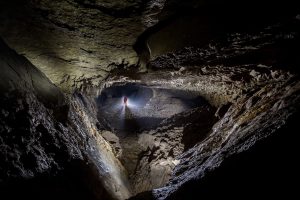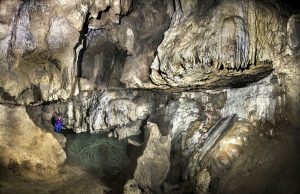
©Piero Lucci, www.venadelgesso.it
Summer, sun, beach – three words that are synonymous with Italy for many holidaymakers. And then, of course, there is the rich cultural and historical heritage, accompanied by excellent cuisine. As if those weren’t enough reasons to visit countless towns and villages, there’s also … fascinating geology? A new UNESCO World Heritage Site is dedicated to precisely this field of research and presents a slightly different side of Emilia Romagna. The evaporitic karst and the caves in the Northern Apennines are dedicated to one of the best-researched karst regions in the world with particularly deep gypsum caves that lead far below the earth’s surface.
Evapo-what, kar-who?
Stone and rock dominate this World Heritage Site – so far, so good. But what is it actually all about? And what makes this region so special? There is, for example, the so-called evaporite, from the Latin “evaporo” (“to evaporate”). It is formed by a chemical reaction in sea and lake basins, in which an evaporation-induced supersaturation of dissolved minerals occurs in the dry climate. Among the most common evaporites or evaporite minerals are halite, anhydrite and gypsum.
Karst, on the other hand, describes a type of terrain that can occur underground (mostly as caves) as well as above ground. It is formed by the precipitation and weathering of various sediments with a mostly underground water supply. Karst landscapes are particularly common in the Mediterranean region, although those in Mediterranean areas, in contrast to comparable areas in Southeast Asia and southern China, have been used for agriculture since ancient times, e.g. for herding cattle. Unsurprisingly, the evaporitic karst of the Northern Apennines with its caves has always carried great intrigue and has been the subject of scientific research since the 16th century.
The geological Northern Apennines
The new World Heritage Site combines quality and quantity, as it covers a total area of 3,600 hectares, spread over seven areas or components. Well over 900 caves over a length of more than 100 kilometres run through this area, which stretches from the south-east to the north-west of Emilia Romagna and includes the provinces of Reggio Emilia, Bologna, Rimini and Ravenna. Large cities as well as natural parks fall under this enormous site, which is also characterised by its scattered, fragmented structure. If you want to visit the entire karst of the Northern Apennines, you will need time and patience. Numerous caves, which lie up to 265 metres below the earth’s surface, are only accessible to geologists and speleologists, others offer guided tours. And yet this area is worth a closer look due to its diversity, importance and outstanding beauty.

©Piero Lucci, www.venadelgesso.it
Seven components, one World Heritage Site
The almost monumental expanse of the Apennines naturally provides the perfect backdrop for imposing rock formations and hidden caves. In the northern part of the mountain range, there are seven areas or components that together make up a World Heritage Site and reveal many a beautiful spot.
- Alta Valle Secchia: Probably the largest part of this new World Heritage Site is located in the Appennino Tosco-Emiliano National Park in the far northwest of Romagna and has the largest karst expanse in the region. Here, the rock creates some bizarre and breathtakingly beautiful formations, for example around the so-called “Fontana Salsa.” This spring not far from the Secchia river is characterised by its high salt content and similarly impressive flow rate. The karst system of Monte Caldina, on the other hand, is home to the deepest evaporite cave in the world, which reaches hundreds of metres below the earth’s surface. Due to the porous gypsum rock, sinkholes are increasingly appearing in the Alta Valle Secchia – a development that is likely to continue.
- Bassa Collina Reggiana: Gypsum stucco from the Bassa Collina Reggina has been regarded as an inexpensive and attractive alternative to conventional gemstones and has been used for architectural and artistic purposes since the 17th Numerous church altars thus bear elements of this karst landscape. This area in the north of Romagna, a little closer to Modena, hides its karst treasures mainly beneath the frequently wooded surface. A mighty cave system awaits around Borzano, topped by a similarly impressive castle.
- Gessi di Zola Predosa: We continue our geological journey southwards and approach Bologna. The smallest karst region in terms of surface area is characterised by astonishing diversity. Various surface forms, such as blind valleys and sinkholes with diameters of up to one kilometre, seemingly alternative with spectacular caves. However, human intervention, primarily in the mining sector, has permanently altered the karst landscape, including the enormous Michele Gortani Cave. Numerous churches, monasteries and medieval settlements are a common thread running through the area.
- Gessi Bolognesi: In the nature park of (almost) the same name, just a few kilometres from Bologna, you will find this relatively temperate hilly area with many forests and fields as well as a few striking rock formations. Numerous caves and karst formations are hidden in Gessi Bolognesi – over 160 to be precise, with a combined total length of around 20 kilometres. Rare wall karst formations, which were scientifically documented as early as 1876, are hidden beneath the surface. However, the Gessi Bolognesi are primarily known for their natural beauty combining grassland and gypsum rock in an astonishingly harmonious way. Idyllic churches and partly abandoned monasteries highlight the almost mystical aura of the nature park.
- Vena del Gesso Romagnola: The second largest karst area of the UNESCO World Heritage Site is located in the nature park of the same name and expands west of Imola and Faenza for over 40 kilometres. Spectacular shades of grey and silver characterise the gypsum-rich rock creating an often almost unreal shimmer that contrasts with the evergreen nature and provides the backdrop for countless hikes along narrow paths. Numerous ruins of ancient religious and military structures line your path, as do the various caves (more than 200!) and hydrogeological tunnels. Some of the oldest cave minerals in the country were found not far from the Banditi Cave, probably formed around 580,000 years ago. Various river terraces within the grottoes and caves give an approximate idea of the force of the water that forged its way through the gypsum over thousands of years.
- Evaporiti di San Leo: There are two other components of this World Heritage Site not far from San Marino. There is also a lot of gypsum rock around San Leo with a huge cave, its origins probably going back many millions of years. Globally unique crystalline shapes give the cave walls a special lustre, in the truest sense of the word. Incidentally, the village of San Leo itself, situated on a huge rock, is well worth a visit and was even mentioned by Dante Aligheri in his “Divine Comedy.”
- Gessi di Onferno: This last cave system is situated south of San Marino, just a few kilometres from the Rimini Riviera. A veritable network of caves with impressive alabaster stone , best admired on a guided tour, is hidden away in the Onferno nature reserve. Bizarre formations of rock and gypsum accompany numerous underground caves and tunnels. Among other things, a huge colony of bats has gathered here, which you can also find out more about. A short detour to the visitor centre with its exciting museums rounds off the tour perfectly.
This newest World Heritage Site in Italy is not only exciting for speleologists. The fascinating rock formations alone make a visit to the karst landscapes and caves of Emilia Romagna essential, not to mention the many small villages nearby, the hikes and the underground tours. With the evaporitic karst and the caves in the Northern Apennines, you will gain completely new insights into a highly exciting region – and that’s something definitely worth checking out.